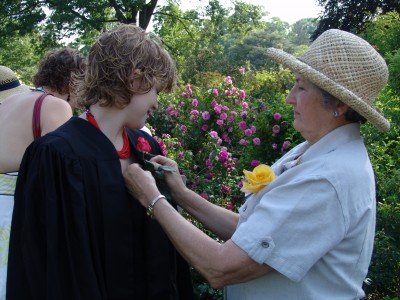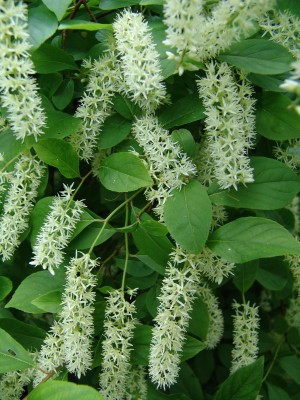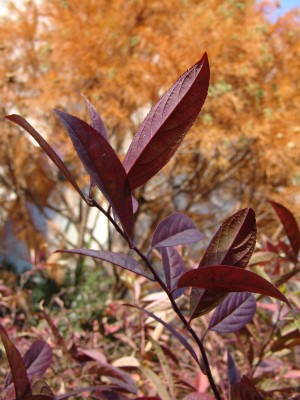Graduation Traditions
This weekend the Arboretum is preparing to participate in one of our favorite traditions with the graduates of Swarthmore College. Prior to marching into the Scott Outdoor Amphitheater and receiving their well-earned diplomas, graduates can meet staff and volunteers from 8:15 to 9:30 am to have a fresh cut rose from the Dean Bond Rose Garden pinned on their gown.
After the ceremony and in addition to receiving roses, graduates are given an Itea virginica ‘Henry’s Garnet’, Virginia sweetspire, as a living memento of their years spent among the gardens of the campus-arboretum. ‘Henry’s Garnet’ was named and introduced by the Scott staff in 1984. It has exceptional fall color lasting from October into December reflecting the Swarthmore College school color of garnet.
It also has long sprays of creamy white, fragrant flowers in the summer, hence the common name of sweetspire. This shrub received the Gold Medal Award from the Pennsylvania Horticultural Society in 1988 for its outstanding qualities.
An adaptable native shrub, sweetspire will grow in full sun or partial shade, although the fall color and flowering will be best in sunny locations. It will thrive in wet sites, but also performs well in fairly dry ones. It is free of serious pests and diseases. At maturity, this shrub will reach 4-6 feet, forming a mound of arching stems.
Because Itea has a growth habit of sending out new shoots throughout its life, graduates can plant this shrub in a family or friend’s garden now (if they don’t have their own garden yet) and in a few years the graduates can transplant it, leaving a piece behind. Itea is hardy in zones 5-9, meaning it will grow from Southern Maine south to Florida and across the Midwest (through the middle of Illinois, Missouri and Ohio) to and through the West Coast states.
We invite you to look at Virginia sweetspire growing in the Teaching Garden behind the Scott office building and in the Rose Garden Circle between McCabe Library and Parrish Hall. This plant will make a great addition to any young or mature garden. We hope this plant will be part of the graduate’s garden and will bring back fond memories of the Scott Arboretum.
We wish all of the 2008 graduates a bright and green future.








romilia
Posted at 17:13h, 31 MayDear Ms. Sawyers,
I was delighted to receive Itea virginica as a living memento of the years my son Gabriel was in your beautiful campus. I carried the plant all the way to Texas.
We live in Cypress, Texas. I hope this plant thrive in this weather. I don’t know anything about plants and I don’t want to spoil this beautiful specimen. I need directions as to how to take care of this plant (it’s still in the container). My husband said, put it in a pot first, let it grow there and then plant it in our garden. Should I put it under the full sun in a small pot? or should I put in in partial shade? When should the plant be able to stand by itself in my garden? Thanks!
Romilia Ramirez
Claire Sawyers
Posted at 07:28h, 02 JuneDear Romilia,
I’m sorry it seems the instructions that were folded up and attached to gift plant got lost —
I suggest planting it directly in your garden in an area where it has room to grow; full sun is fine but it will also take part shade. Keep it well watered until it becomes established (general rule of thumb is “every day for a week, every week for a month, every month for a year”), but as needed. Ita is adaptalbe, growing in standing water is some parts of its range, so I don’t think you can overwater it. While it is small now, if you plant it in a pot, it runs a greater risk of drying out, unless you are a regular container grower and water daily, but you could do so to have it gain some size and then plant it out in the fall.
Ultimately it will get 4-5 feet tall and send up multiple stems. When it reaches that size, it can be divided and so your son can move a piece to his own garden and you can keep a piece.
If you search on line about Itea virginica ‘Henry’s Garnet’ you will find a number of additional excellent photographs and additional cultural information. Good luck with it!
Glad to know you are keen to take good care of this symbolic plant thati s also a great landscape plant and congratulations on your son’s graduation!
CS
Melanie Contreras
Posted at 15:07h, 12 SeptemberI was thrilled when my son’s “Henry’s Garnet”, painstakingly packed in my suitcase, safely made the trip post graduation back to Los Angeles. The plant had been thriving in a pot, growing quite a bit over the past few months. I was so sad when I noticed the pot had been knocked over yesterday and the main part of the plant had been broken, literally hanging on by one small root thread. There is still a bit of “stalk” firmly in the pot. I have put the broken piece securely back into the pot, next to the “stalk”, and am making sure the soil remains very wet. Is there a chance it could possibly re-root? Will the remaining stalk have a chance of growing as well? Please advise. Thanks so much.
Melanie
Andrew Bunting
Posted at 08:24h, 13 SeptemberMelanie,
You could root the part that was broken off, but it would be best to put it in a separate pot with an equal mix of potting soil and perlite. You can re-cut the end of the cutting and add a rooting hormone such as Rootone, and then cover the pot with a clear plastic bag thus creating a greenhouse effect. The cutting should root in 3-4 weeks. The plant where the branch broke off should also re-sprout a new plant from the base.
Sincerely,
Andrew Bunting, Curator
Scott Arboretum
Melanie Contreras
Posted at 00:11h, 14 SeptemberHi Andrew –
Thank you for your quick reply! I will find my inner green thumb and take care of the plant per your suggestions. Wish me luck!
Happy thoughts –
Melanie